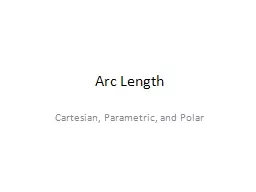

Cartesian Parametric and Polar Arc Length x k1 x k Green line If we do this over and over from every x k1 to any x k we get Arc Length If we make x infinitely small we have the Riemann Sum ID: 140056
Download Presentation The PPT/PDF document "Arc Length" is the property of its rightful owner. Permission is granted to download and print the materials on this web site for personal, non-commercial use only, and to display it on your personal computer provided you do not modify the materials and that you retain all copyright notices contained in the materials. By downloading content from our website, you accept the terms of this agreement.
Slide1
Arc Length
Cartesian, Parametric, and PolarSlide2
Arc Length
x
k-1
x
k
Green line =
If we do this over and over from every
x
k—1
to any
x
k
, we get Slide3
Arc Length
If we make
x
infinitely small, we have the Riemann Sum
OR
If
y
is a smooth function of
x
.
If x is a smooth function of
y.Slide4
Arc Length
Example:
Without a calculator, find the arc length of the curve
for 0 x 1.Slide5
Arc Length
Find the length of the curve between
x =
8 and x =
8.
Since y is NOT DIFFERENTIABLE between –8 and 8, we must use x in terms of y.
fIntSlide6
Surface Area
The surface area of a solid of revolution depends on the radius (the distance between the graph and the axis of revolution) and the arc length.Slide7
Surface Area
Find the area of the surface formed by revolving the graph of on the interval [0, 1] about the x-axis.
Use u-sub.Slide8
Surface Area
Find the area of the surface formed by revolving the graph of
f(x) = x
2
on the interval about the y-axis.
In this case, the r(x) is
x since the axis of revolution is the y-axis.Slide9
The equation for the length of a parametrized curve is similar to our previous “length of curve” equation:
(Notice the use of the Pythagorean Theorem.)
(proof on pg.
721)Slide10
Parametric Arc Length
A circle of radius 1 rolls around the circumference of a larger circle of radius 4. The
epicycloid
traced by a point on the circumference of the smaller circle is given by
and
Find the distance traveled by the point in one complete trip about the larger circle.Slide11
Likewise, the equations for the surface area of a parametrized curve are similar to our previous “surface area” equations:Slide12
The length of an arc (in a circle) is given by r
.
q
when q is given in radians.
Area Inside a Polar Graph:
For a very small q, the curve could be approximated by a straight line and the area could be found using the triangle formula:Slide13
We can use this to find the area inside a polar graph.Slide14
Example: Find the area enclosed by:
This graph is called a lima
ƈon
.Slide15Slide16
Notes:
To find the area between curves, subtract:
Just like finding the areas between Cartesian curves, establish limits of integration where the curves cross.Slide17
When finding area, negative values of
r
cancel out:
Area of one leaf times 4:
Area of four leaves:Slide18
To find the length of a curve:
Remember:
Again, for polar graphs:
If we find derivatives and plug them into the formula, we (eventually) get:
So:Slide19
There is also a surface area equation similar to the others we are already familiar with:
When rotated about the x-axis: